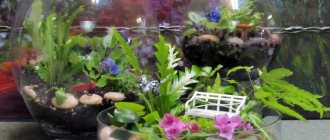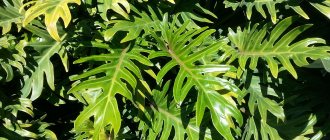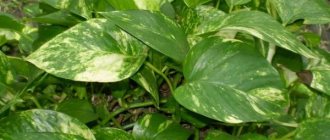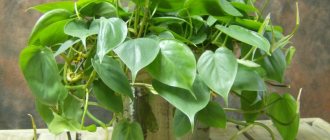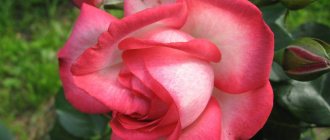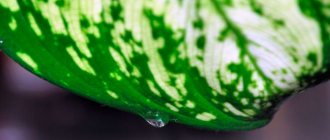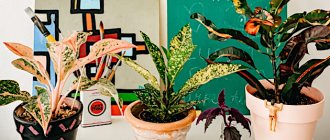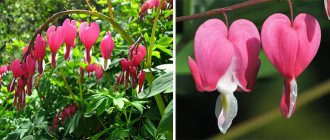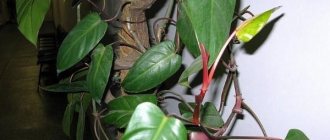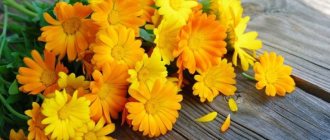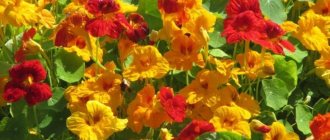Description and photo
A decorative vine that perfectly purifies indoor air. Fast growing, shade tolerant. The stems of the flower are densely dotted with green, slightly wrinkled, heart-shaped leaves. Young philodendron leaves are thin, delicate, and bronze in color.
Over time, the leaf blade darkens, acquiring a rich green color. The leaf size can reach 10-15 cm in length and about 8-10 cm in width. The stem of the plant is equipped with clinging aerial roots.
Philodendron vines: climbing varieties
Philodendron flower Imperial Red, Jungle Boogie, Minarum, Lacerum, Imperial Green
The vine-shaped plant is kept at home for its beautiful leaves. They are suitable for large rooms, offices or halls.
Note! The size of the leaves and their external characteristics largely depend on the type of plant chosen. They vaguely resemble oak leaves.
Philodendron Brazil
Philodendron Brazil is a climbing vine with bright green leaves that can reach 50 cm in length. There is yellow variegation on the leaves. The Brazilian philodendron is an epiphyte, and therefore the soil should be rich in nutrients, but at the same time light. This species suffers from a lack of air humidity, so it is recommended to grow it in greenhouse conditions.
Philodendron Scandence Brazil
Philodendron Scandance Brazil is the most popular variety. The leaves are heart-shaped and shiny, bright green with a distinct hint of yellow. In the wild it grows on the rocks of Central America.
Care is quite simple: philodendron from Brazil needs bright, diffused light throughout the day. If there is not enough light, the flower will begin to stretch and the leaves will become smaller.
Important! The air temperature in the room should not be lower than 23 °C in the hot season and not lower than 16 °C in the cold season. The soil should always be slightly moist, it is worth ventilating the room often, but the flower should not be in a draft.
Scandance Brazil
Philodendron graceful
Philodendron graceful is a massive vine with a woody stem. Each leaf is cut into 8 or more lobes, the width of each of which is about 2 cm. The plant can reach a length of 3 m. It requires loose, moisture-absorbing soil. Soil for deciduous plants can be used as a substrate. Don't forget about drainage.
The graceful plant blooms from January to December. It is quite simple to grow, and therefore even a novice gardener can propagate it.
Note! It is recommended to place the flower pot near the western and eastern windows. Exposure to direct sunlight for a short period of time is acceptable.
During the period of active growth it is necessary to apply fertilizing. It is better to avoid this during the rest period. The air humidity in the room should be at least 60%, since such conditions exist in their habitats. The temperature should be kept in the range from 18 °C to 25 °C.
Graceful look
Philodendron Decurence
Philodendron Decurens is a fairly rare plant that adapts well to different conditions. More than others, it is adapted to growing in an apartment. The long leaves are green above and red below.
For your information! There are quite a few hybrids of these plants that can reproduce naturally. This happens due to different flowering times and large distances. All species are pollinated by different beetles, since they grow at different altitudes.
Philodendron billitae
Philodendron species Billitae is a collectible. The plant has long narrow green leaves. The root system beautifully wraps around the support.
Philodendron Scandens Micans
Bush philodendron variety Scandens Micans is suitable for vertical gardening, as well as for growing indoors. Glossy green heart-shaped leaves can reach 15 cm in length. The variety is the most unpretentious of its kind, since it can grow even in unfavorable conditions.
Every 2-3 years it is recommended to replant the plant. Propagation is available by cuttings, seeds and pieces of trunk. It is recommended to use a slightly acidic or neutral substrate. Can be planted hydroponically.
Important! The sap of the plant is poisonous and can irritate the skin and mucous membranes, so it is recommended to wear rubber gloves, a respirator and goggles when pruning or collecting planting material.
Scandens Micans
Philodendron elegans
Philodendron elegans' lyre-shaped leaves give it its name. Basically, cutting into narrow plates of about 3 cm in width does not exceed 8. A well-developed stem gradually becomes lignified.
Philodendron Rugosum
Philodendron species Rugosum is a perennial evergreen plant. The lush vine can reach a length of 2 m. The young foliage is shiny, heart-shaped and grows about 10 cm in length. Cylindrical inflorescences have flowers of both sexes.
Depending on the species, you can find a vine with different shapes and colors of leaves (you won’t be able to find a tricolor, but some have variegation). Simple plant care will not cause any trouble even for novice gardeners who want to decorate their home with an unusual specimen.
Nesquik Opti-Start instant cocoa drink, 500 g (package)
170 ₽ More details
Nesquik Opti-Start instant cocoa drink, 500 g (package)
170 ₽ More details
Submersible pumps
Varieties
Brazil (p. Scandens Brazil)
The most common representative. The stem is equipped with wide heart-shaped leaves with pointed tips. The leaf blade is green with expressive yellow spots and stripes.
Important! With a lack of lighting, the plant stretches and the leaves become smaller.
Mikans (p. Scandens Micans)
The most unpretentious representative. A small, thin-trunked vine, suitable for indoor growing and vertical gardening.
Characteristic are velvety, dark green leaves with a burgundy tint, heart-shaped.
Peculiarities
Scandens is the most shade-tolerant type of philodendron. Low branching, climbing. However, it requires sunlight to develop. Has long and flexible shoots. The leaf plate is heart-shaped with a glossy sheen.
Bloom
Inflorescences can be seen when growing philodendron in a winter garden or greenhouse (it does not bloom at home).
The type of inflorescence is small cobs, wrapped in a blanket-hood. A play of color palettes from white to violet.
- Flowering time. Occurs in early spring or summer.
- Fetus. A berry, usually white, containing very small seeds inside.
Secret No. 1. Individual approach
The main, and perhaps the most reliable advice that can be given (and received) when buying a philodendron is to be sure to study all the features of a particular species and even variety. After all, some varieties of these plants are more hardy than other varieties. And the “scatter” in the requirements for growing conditions and care for different types of philodendrons can be very large. Some plants are better adapted to indoor environments or specific locations than others.
Thus, shade tolerance is an excellent characteristic of the ivy-leaved Philodendron ( Philodendron hederaceum
)
- climbing philodendron ( Philodendron hederaceum
var.
hederaceum
), which can be used for complete landscaping in the back of the room.
The blushing philodendron can also keep it company , but other species grow better in a scattered light place and in partial shade.
Philodendron bipinnatifidum - with its almost meter-long beautifully cut leaves - is not the best candidate for small rooms and apartments. In any case, when purchasing, it is worth checking how demanding your philodendron is regarding air humidity, what maximum size it can reach, and whether it is easy to control. With this check you will save yourself from dozens of problems.
Climbing Philodendron, or Clinging Philodendron (Philodendron hederaceum var. hederaceum)
Reddish Philodendron, or Blushing Philodendron (Philodendron erubescens)
Philodendron bipinnatifidum, or Philodendron bipinnatifidum
Landing
Choosing a pot
The size of the container should be slightly larger than the root system of the flower (radius about 10-12 cm). There must be a drainage hole and drainage.
A support corresponding to the length of the vine is installed in the center of the pot (the support should not be completely smooth).
The soil
The best option is fertile light soil for decorative deciduous crops. It is possible to use a universal soil mixture for potted plants. Scandens Micans can be grown using hydroponics.
Landing rules
The favorable period is the beginning or middle of spring.
- Drainage is placed at the bottom of the pot, soil is poured on top.
- The roots of the plant are completely covered with soil (they do not cover the growing point).
- Water the plant abundantly.
Air layering:
- pre-moisten the soil;
- layering in the soil, fixed with wire or pins;
With a cutting or a leaf with a “heel”:
Planting material is placed in cold water. After the roots appear, they are planted in the soil.
- placed in moist soil;
- create greenhouse conditions - cover with a cut-off plastic bottle with an open neck;
- after 2-3 weeks they are planted in separate permanent pots.
Reproduction
The presence of aerial roots makes it easy to solve the question of how to propagate the plant. The simplest way is cuttings. Breeders use seeds, but the process takes much longer.
Cuttings
The plant takes root best in the warm season at temperatures up to +30°C.
To do this, perform the following actions:
- Cut off a stem with 2-3 internodes below the aerial root. Treat the cut with coal powder. If you only have a cutting without roots to work with, you need to put it in a container with water and wait for the root to appear.
- Plant the cuttings in prepared, disinfected soil.
- Cover the cutting with a transparent bag or glass jar to maintain high humidity inside. Ventilate every 2 days, if necessary, moisten with warm, settled water.
- The cover is removed after the appearance of new leaves, which indicate successful rooting.
Did you know? Philodendron is translated from ancient Greek as “I love the tree” and describes the way it exists in its native environment.
Seeds
Seeds are sown in spring.
The sequence of the process is as follows:
- Place the seeds into the prepared disinfected mixture to a depth of 5 mm.
- Moisten the soil by spraying with warm, settled water from a spray bottle.
- Cover the crop with glass or transparent film and place the box in a warm place.
- Maintain high humidity in the container and wait for seedlings to appear in about 1.5 months.
- After the first true leaves appear, plant the seedlings in separate containers.
Home care
Temperature
In summer the temperature in the room is not higher than 22-23°C, in winter – not lower than 15-16°C. Afraid of drafts.
Lighting
The flower loves bright, diffused light throughout the day, but can also grow in shade. Direct sunlight can cause leaf burns.
Grows well in artificial light. Prefers north-east or north-west windows.
Watering
Prefers moderate, gentle watering with settled water. The water from the pan is immediately drained.
In the autumn-winter period, watering is reduced, but the roots are monitored for drying out.
In summer, the plant is sprayed or wiped with a damp cloth.
Top dressing
Mineral or organic fertilizers are applied monthly - from early spring to early autumn. You can use complex fertilizers for decorative deciduous plants.
Trimming
Regular pruning of old shoots is necessary - this promotes luxurious growth of the plant. New shoots appear at the cutting site.
Transfer
Produced in late March - early April. Young plants are replanted every year, adults - once every 3-4 years. The size of the pot is 5-7 cm larger than the previous one. Use new drainage.
Handle the plant if the roots are strongly intertwined. Within 2 weeks, the plant must be sufficiently shaded and excessive watering should be avoided.
Flowering period
Philodendron Scandens does not bloom at home. The absence of flowering in the greenhouse indicates insufficiently comfortable conditions for keeping the plant.
Philodendron climbing
Philodendron climbing is the best option for an apartment. The development of this species does not require much space, and therefore it can be grown like any hanging plant in a hanging pot. An unpretentious option.
What is Philodendron
Description of the plant
Perennial plant of the Araceae family. Habitat in the wild is the tropics of Latin America, Australia, Mexico. Depending on the variety and type of plant, its appearance may differ. The branched rhizome of this vine is superficial. Each internode forms roots on its own. The finest hairs sprout and become attached to tree trunks or walls.
For your information! The long, thin stem can reach 2-3 m. Part of the shoot is gradually covered with bark, so the flower does not need additional support, since the wood is quite dense.
climbing view
Diseases and pests
- Stem rot. The reason is excessive watering. Control measures: trim the trunk and re-root.
- Bacterial spotting. The reasons are increased humidity and ambient temperature. Control measures: removal of damaged areas. Fungicide treatment.
- Scale insects, thrips, mealybugs, spider mites. Control measures: treatment with soap solution, karbofos, acaricides.
Secret No. 7. Humidification of support and air
Most indoor philodendrons are vines. And for success in growing them, do not forget to moisten the supports (if, of course, you use the usual support for these plants, covered with moss or a synthetic substitute material). The support should never dry out completely.
But this is not all the moisture measures: philodendrons also love high air humidity, so additional measures need to be taken for the plant. Spraying is not the best option. For philodendrons, it is better to choose a simple method with a “handicraft” or home humidifier - placing stands or trays with moisture-retaining materials.
Do not forget to wipe the leaves from dust - any philodendron responds to such care with a brighter color.
